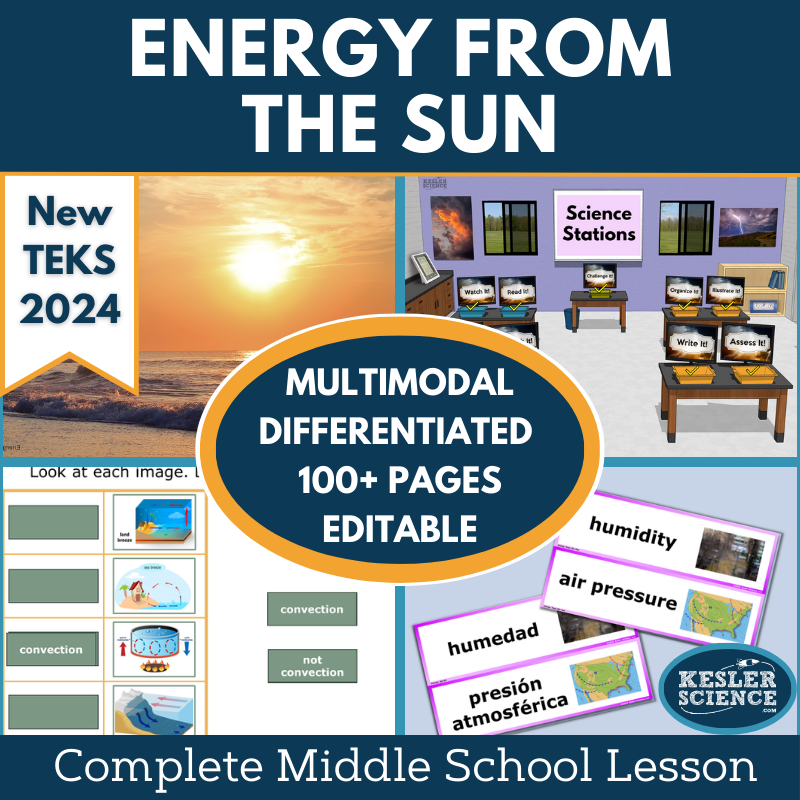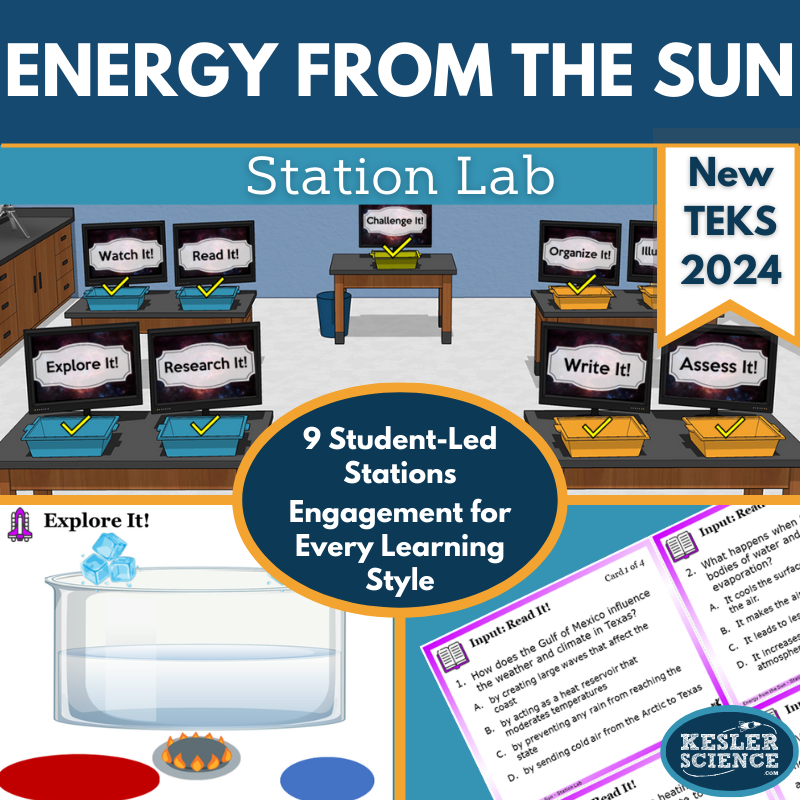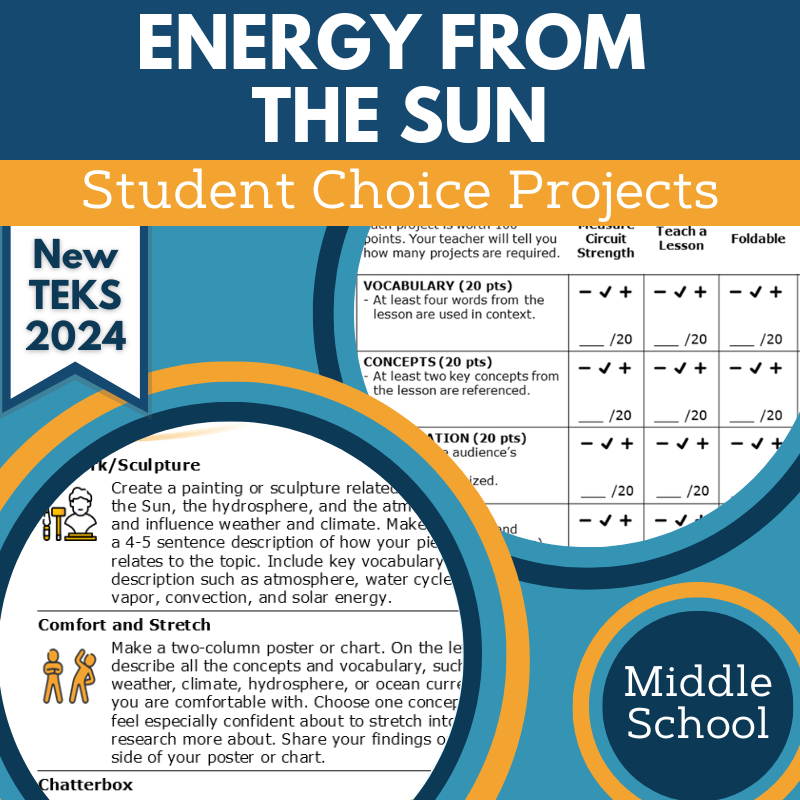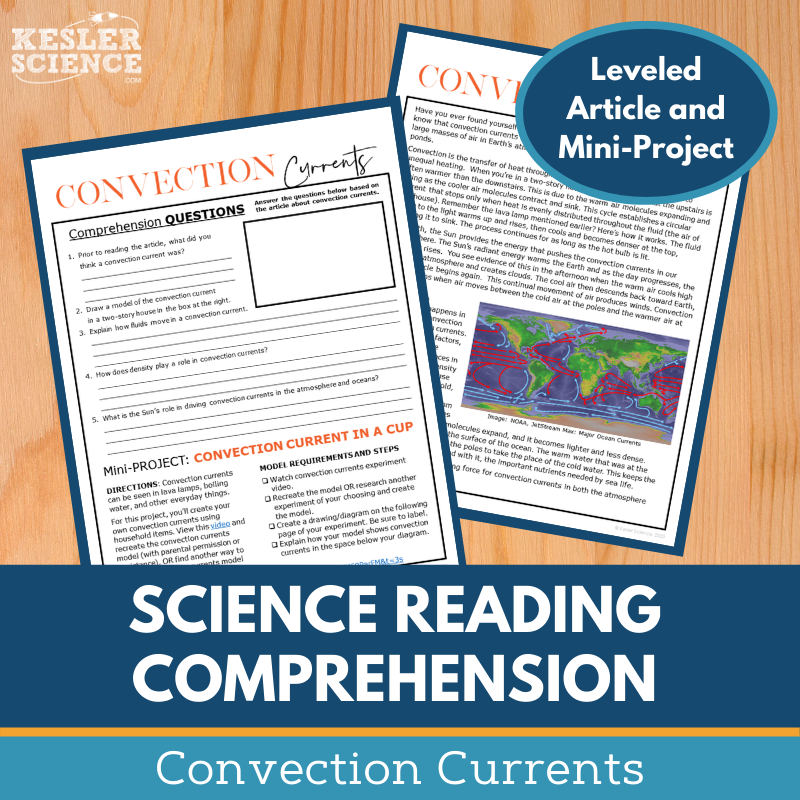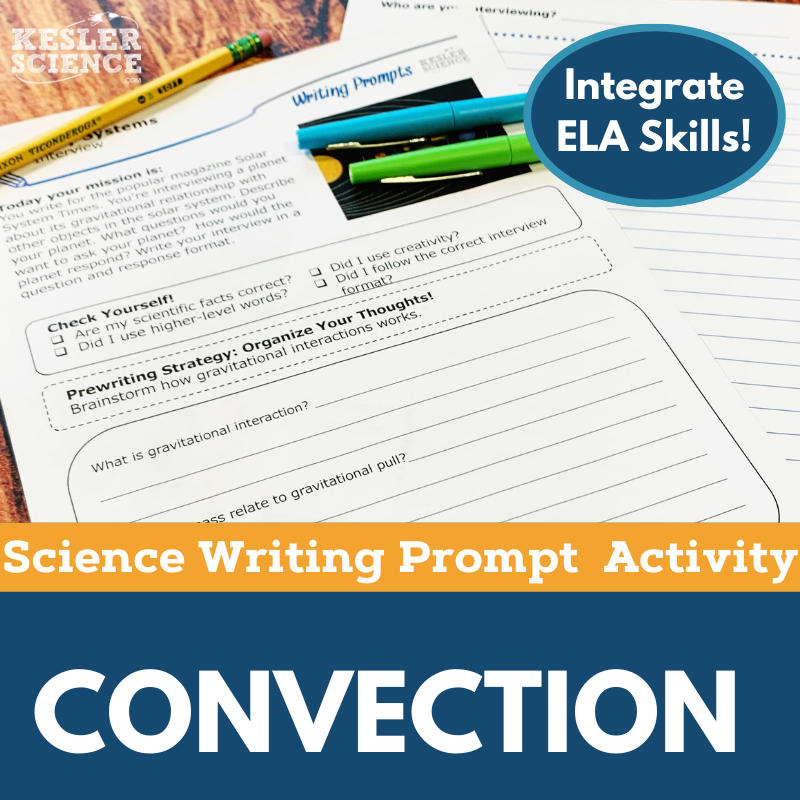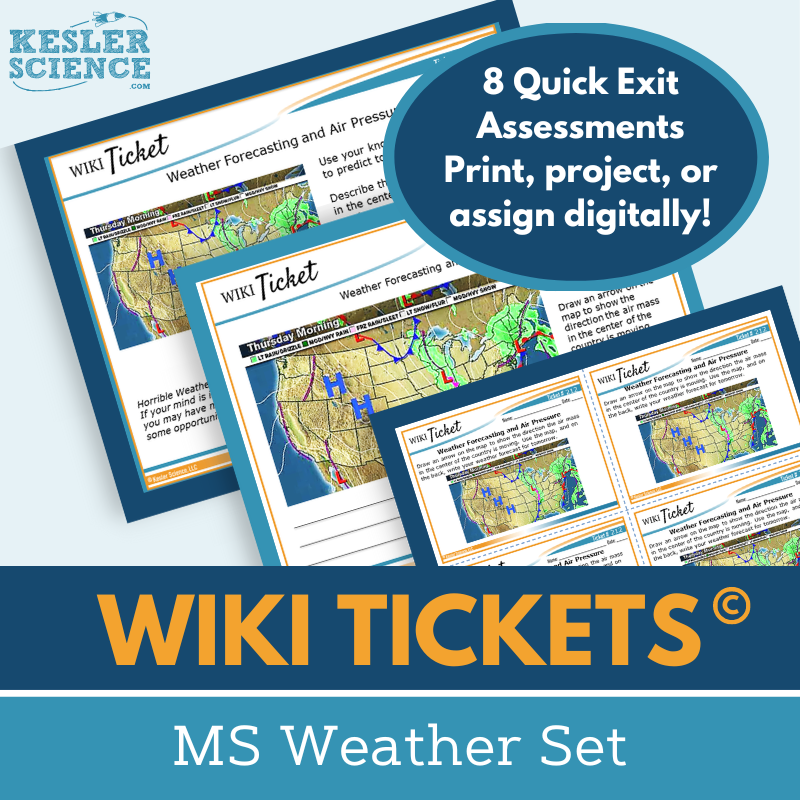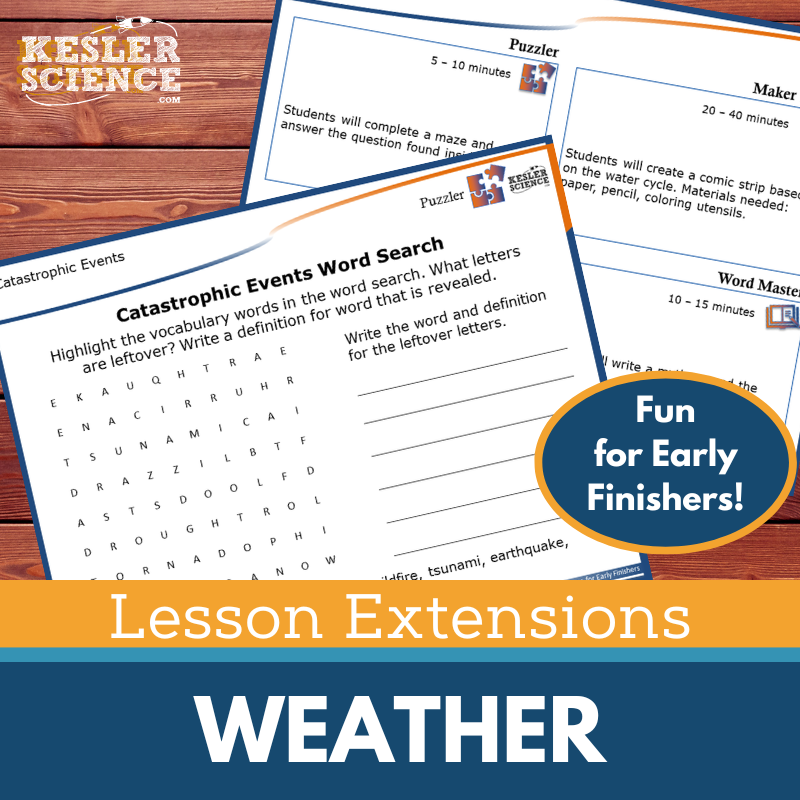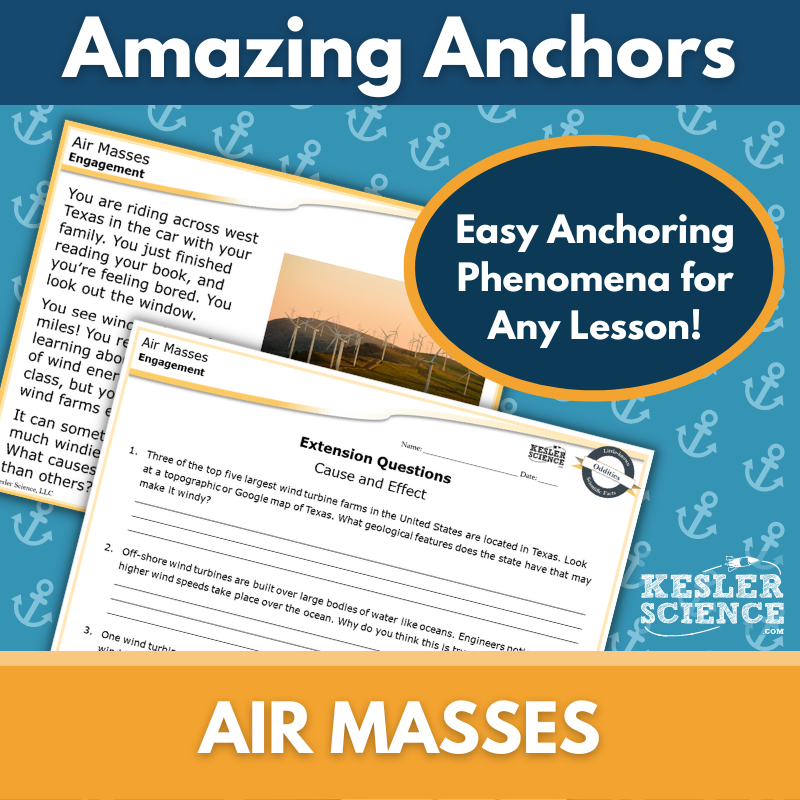Energy from the Sun Activities for Middle School Science
Understanding weather and climate is essential for middle school students, but it can be a challenging concept to grasp! The resources below will give students a comprehensive understanding of energy from the Sun. All of the following materials are also included in the Kesler Science Membership.
The Kesler Science Weather Unit is an engaging middle school lesson on how energy from the Sun, hydrosphere, and atmosphere interact to influence weather and climate. It includes editable PowerPoints, worksheets, assessments, and student-choice projects, all designed for differentiated, student-led learning with minimal prep.
Following the 5E Model, the unit provides engagement activities, a hands-on exploration station lab, editable PowerPoints, and interactive notebooks in English and Spanish. Students demonstrate their learning through choice projects and STAAR 2.0-aligned assessments, with flexible digital and printable formats to fit any classroom.
Aligned with the 2021 TEKS 8.10A standard, this lesson is ideal for in-class or virtual learning. Bundle options offer savings on multiple topics or the complete curriculum, making it a comprehensive resource for teaching weather and climate in middle school science.
The Kesler Science Weather Unit is an engaging middle school lesson on how energy from the Sun, hydrosphere, and atmosphere interact to influence weather and climate. It includes editable PowerPoints, worksheets, assessments, and student-choice projects, all designed for differentiated, student-led learning with minimal prep.
Following the 5E Model, the unit provides engagement activities, a hands-on exploration station lab, editable PowerPoints, and interactive notebooks in English and Spanish. Students demonstrate their learning through choice projects and STAAR 2.0-aligned assessments, with flexible digital and printable formats to fit any classroom.
Aligned with the 2021 TEKS 8.10A standard, this lesson is ideal for in-class or virtual learning. Bundle options offer savings on multiple topics or the complete curriculum, making it a comprehensive resource for teaching weather and climate in middle school science.
Engage your middle school students with this student-led station lab aligned with TEKS 8.10A, exploring how energy from the Sun interacts with the hydrosphere and atmosphere to influence weather and climate. Designed for in-class or virtual learning, this modular lesson promotes independent and small-group work while minimizing teacher prep time.
Students interact with nine differentiated stations that offer multimodal learning experiences. They explore concepts through hands-on activities, video analysis, reading comprehension, and research. Output stations allow students to demonstrate understanding by organizing information, illustrating models, writing responses, and completing assessments. A bonus challenge station provides extension activities for advanced learners.
This high-engagement resource fosters critical thinking and active participation in Earth and weather science.
Engage your middle school students with this student-led station lab aligned with TEKS 8.10A, exploring how energy from the Sun interacts with the hydrosphere and atmosphere to influence weather and climate. Designed for in-class or virtual learning, this modular lesson promotes independent and small-group work while minimizing teacher prep time.
Students interact with nine differentiated stations that offer multimodal learning experiences. They explore concepts through hands-on activities, video analysis, reading comprehension, and research. Output stations allow students to demonstrate understanding by organizing information, illustrating models, writing responses, and completing assessments. A bonus challenge station provides extension activities for advanced learners.
This high-engagement resource fosters critical thinking and active participation in Earth and weather science.
The Energy from the Sun Student Choice Projects align with the 2021 TEKS 8.10A standard, allowing middle school students to select a project that best fits their preferred output style. A project page outlines six student-led options plus a “design your own” project, with an editable rubric for teacher, peer, or self-assessment. This resource is also included in the Energy from the Sun Complete Lesson for TEKS 8.10A.
These flexible, multimodal projects give students creative ways to demonstrate their understanding. Two versions of the project page support differentiation, with modified options for students needing remediation and challenge options for advanced learners. Teachers can adjust the rubric to fit grading needs.
Projects require standard classroom supplies like paper, markers, and scissors, with many options available for digital completion. Also available in the Weather Bundle (five topics for grades 6-8) and the MEGA Student Choice Project Bundle (84 topics) for grades 6-8.
The Energy from the Sun Student Choice Projects align with the 2021 TEKS 8.10A standard, allowing middle school students to select a project that best fits their preferred output style. A project page outlines six student-led options plus a “design your own” project, with an editable rubric for teacher, peer, or self-assessment. This resource is also included in the Energy from the Sun Complete Lesson for TEKS 8.10A.
These flexible, multimodal projects give students creative ways to demonstrate their understanding. Two versions of the project page support differentiation, with modified options for students needing remediation and challenge options for advanced learners. Teachers can adjust the rubric to fit grading needs.
Projects require standard classroom supplies like paper, markers, and scissors, with many options available for digital completion. Also available in the Weather Bundle (five topics for grades 6-8) and the MEGA Student Choice Project Bundle (84 topics) for grades 6-8.
The Convection Currents Inquiry Lab aligns with TEKS, guiding students to understand how the Sun’s energy drives convection within the atmosphere and oceans, leading to the formation of winds and ocean currents. In this investigation, students explore the rate at which radiation heats solids compared to liquids and observe how warm air masses rise due to convection. This hands-on experiment helps students develop a clearer understanding of energy transfer in Earth's systems.
The lab includes three differentiated versions to meet varying student needs. The dependent version offers guided instructions and inquiry questions, ideal for on-level learners. The modified version provides a more structured experience with simplified questions and sentence stems for students requiring additional support. The independent version encourages advanced learners to take ownership of the investigation, making their own decisions and engaging with minimal guidance.
Comprehensive teacher resources are provided, including preparation tips, objectives, materials lists, and answer keys. Reflection questions encourage students to apply the Claim, Evidence, and Reasoning (CER) framework to analyze their results. Using accessible materials such as thermometers, beakers, sand, water, a heat lamp, and a map highlighting San Francisco and Wichita, students gain practical experience modeling convection currents and understanding how unequal heating and Earth’s rotation influence climate patterns.
The Convection Currents Inquiry Lab aligns with TEKS, guiding students to understand how the Sun’s energy drives convection within the atmosphere and oceans, leading to the formation of winds and ocean currents. In this investigation, students explore the rate at which radiation heats solids compared to liquids and observe how warm air masses rise due to convection. This hands-on experiment helps students develop a clearer understanding of energy transfer in Earth's systems.
The lab includes three differentiated versions to meet varying student needs. The dependent version offers guided instructions and inquiry questions, ideal for on-level learners. The modified version provides a more structured experience with simplified questions and sentence stems for students requiring additional support. The independent version encourages advanced learners to take ownership of the investigation, making their own decisions and engaging with minimal guidance.
Comprehensive teacher resources are provided, including preparation tips, objectives, materials lists, and answer keys. Reflection questions encourage students to apply the Claim, Evidence, and Reasoning (CER) framework to analyze their results. Using accessible materials such as thermometers, beakers, sand, water, a heat lamp, and a map highlighting San Francisco and Wichita, students gain practical experience modeling convection currents and understanding how unequal heating and Earth’s rotation influence climate patterns.
In this engaging lesson, students explore the movement of air masses and their impact on local weather through an informative nonfiction article. They answer comprehension questions and create a graphic organizer to summarize key concepts. Designed for grades 6-8 (and advanced 5th graders), the resource includes two Lexile-leveled passages (1100-1300) to support science literacy and differentiation.
The lesson features 5-7 comprehension questions, a hands-on mini-project, and a Cornell notes template. Engaging, printable graphics enhance comprehension, and the resource is compatible with Google Classroom, MS Teams, Schoology, and Canvas, making it ideal for in-class or virtual learning. Students can annotate and respond directly within the digital document for seamless integration.
Perfect for absent students, sub plans, extra credit, or whole-class instruction, this flexible resource strengthens science literacy, discussion, and critical thinking. The Science Reading Comprehension Passages Vol. 1 bundle includes 40 additional passages, providing even more opportunities for skill-building and comprehension practice.
In this engaging lesson, students explore the movement of air masses and their impact on local weather through an informative nonfiction article. They answer comprehension questions and create a graphic organizer to summarize key concepts. Designed for grades 6-8 (and advanced 5th graders), the resource includes two Lexile-leveled passages (1100-1300) to support science literacy and differentiation.
The lesson features 5-7 comprehension questions, a hands-on mini-project, and a Cornell notes template. Engaging, printable graphics enhance comprehension, and the resource is compatible with Google Classroom, MS Teams, Schoology, and Canvas, making it ideal for in-class or virtual learning. Students can annotate and respond directly within the digital document for seamless integration.
Perfect for absent students, sub plans, extra credit, or whole-class instruction, this flexible resource strengthens science literacy, discussion, and critical thinking. The Science Reading Comprehension Passages Vol. 1 bundle includes 40 additional passages, providing even more opportunities for skill-building and comprehension practice.
The Convection Science Writing Prompt Activity helps middle school students deepen their understanding of Earth science through a fun and engaging skit or drama-based exercise. This creative activity encourages students to extend their scientific reasoning while developing their writing skills. Designed for both in-class and virtual learning, it ensures students stay engaged inside and outside the classroom.
Aligned with TEKS and NGSS standards, this low-prep, high-quality resource is ideal for elaboration, review, or integration with other Kesler Science products. It includes teacher directions, project ideas, rubrics (full and half-sheet), projection-ready prompts, full-sized handouts, and a digital interactive version for Google Slides or PowerPoint.
This versatile writing activity is perfect for cross-curricular learning, formative assessments, student choice projects, early finishers, extra credit, and differentiation. Students can display their work on bulletin boards or compile them into an anthology for a lasting collection. With 145 topics available, this engaging resource provides a unique way to reinforce science literacy and critical thinking.
The Convection Science Writing Prompt Activity helps middle school students deepen their understanding of Earth science through a fun and engaging skit or drama-based exercise. This creative activity encourages students to extend their scientific reasoning while developing their writing skills. Designed for both in-class and virtual learning, it ensures students stay engaged inside and outside the classroom.
Aligned with TEKS and NGSS standards, this low-prep, high-quality resource is ideal for elaboration, review, or integration with other Kesler Science products. It includes teacher directions, project ideas, rubrics (full and half-sheet), projection-ready prompts, full-sized handouts, and a digital interactive version for Google Slides or PowerPoint.
This versatile writing activity is perfect for cross-curricular learning, formative assessments, student choice projects, early finishers, extra credit, and differentiation. Students can display their work on bulletin boards or compile them into an anthology for a lasting collection. With 145 topics available, this engaging resource provides a unique way to reinforce science literacy and critical thinking.
The WIKI Tickets© formative assessments for 6th-8th grade science offer engaging ways to check student understanding of weather-related topics. This set includes eight assessments, each available in five formats: a full-screen display for projection, three printable handout sizes, and an interactive digital version compatible with PowerPoint and Google Slides.
Aligned with NGSS and TEKS standards, every standard is covered with at least one ticket, and a bonus table of contents file is included to show alignment. These assessments are versatile and can be used in both in-person and virtual learning environments.
Topics covered include catastrophic events, the greenhouse effect, natural hazards, ocean currents, oceans and weather systems, the water cycle, weather maps, and wind patterns. Designed to be colorful and engaging, WIKI Tickets© can be used as exit tickets, bellringers, or quick checks for understanding. They can be projected, printed, or assigned digitally for flexible use in any classroom setting.
The WIKI Tickets© formative assessments for 6th-8th grade science offer engaging ways to check student understanding of weather-related topics. This set includes eight assessments, each available in five formats: a full-screen display for projection, three printable handout sizes, and an interactive digital version compatible with PowerPoint and Google Slides.
Aligned with NGSS and TEKS standards, every standard is covered with at least one ticket, and a bonus table of contents file is included to show alignment. These assessments are versatile and can be used in both in-person and virtual learning environments.
Topics covered include catastrophic events, the greenhouse effect, natural hazards, ocean currents, oceans and weather systems, the water cycle, weather maps, and wind patterns. Designed to be colorful and engaging, WIKI Tickets© can be used as exit tickets, bellringers, or quick checks for understanding. They can be projected, printed, or assigned digitally for flexible use in any classroom setting.
Lesson Extensions provide engaging, student-choice activities designed to challenge early finishers and deepen their understanding of weather concepts aligned with NGSS and TEKS standards. These activities are ideal for filling downtime, wrapping up lessons, or offering enrichment through rigorous yet enjoyable learning opportunities.
Each extension features four interactive activities: Puzzler for problem-solving challenges, Maker Space for hands-on STEAM projects, Tech Connection for digital demonstrations, and Word Master for creative writing. Resources include teacher directions, answer keys, and both projection and printable versions for flexible use.
Topics covered include catastrophic events, convection in the atmosphere, hurricane formation, pressure systems and fronts, and the water cycle. These high-level materials encourage critical thinking and creativity, supporting independent learners who are ready to dive deeper into weather science.
Lesson Extensions provide engaging, student-choice activities designed to challenge early finishers and deepen their understanding of weather concepts aligned with NGSS and TEKS standards. These activities are ideal for filling downtime, wrapping up lessons, or offering enrichment through rigorous yet enjoyable learning opportunities.
Each extension features four interactive activities: Puzzler for problem-solving challenges, Maker Space for hands-on STEAM projects, Tech Connection for digital demonstrations, and Word Master for creative writing. Resources include teacher directions, answer keys, and both projection and printable versions for flexible use.
Topics covered include catastrophic events, convection in the atmosphere, hurricane formation, pressure systems and fronts, and the water cycle. These high-level materials encourage critical thinking and creativity, supporting independent learners who are ready to dive deeper into weather science.
This no-prep Amazing Anchors lesson introduces air masses and weather through real-world applications. The two-part resource begins with an introductory reading on wind turbines, accompanied by comprehension and extension questions to set the stage for deeper learning. A second reading explains the science behind air masses and weather, reinforcing understanding with additional questions.
This resource includes teacher directions, answer keys, projection slides, a digital version for LMS platforms, and printable handouts. Aligned with NGSS MS ESS2-5, it helps students connect weather patterns to real-world phenomena, making complex concepts engaging and accessible.
Designed for both in-class and virtual learning, this lesson is print- and digital-friendly. A modified version with sentence starters and simplified language supports differentiation, ensuring all students can engage meaningfully with the material. Whether used as an introduction or a wrap-up, this interactive, standards-aligned resource strengthens science literacy and critical thinking.
This no-prep Amazing Anchors lesson introduces air masses and weather through real-world applications. The two-part resource begins with an introductory reading on wind turbines, accompanied by comprehension and extension questions to set the stage for deeper learning. A second reading explains the science behind air masses and weather, reinforcing understanding with additional questions.
This resource includes teacher directions, answer keys, projection slides, a digital version for LMS platforms, and printable handouts. Aligned with NGSS MS ESS2-5, it helps students connect weather patterns to real-world phenomena, making complex concepts engaging and accessible.
Designed for both in-class and virtual learning, this lesson is print- and digital-friendly. A modified version with sentence starters and simplified language supports differentiation, ensuring all students can engage meaningfully with the material. Whether used as an introduction or a wrap-up, this interactive, standards-aligned resource strengthens science literacy and critical thinking.
Year-Round Resources
These year-round activities will increase your students' understanding of many middle school science topics. All of these activities are also included in the Kesler Science Membership.
Visual Data & Graphing
You're not alone if your students struggle with understanding graphs, charts, and tables. It's a skill that takes an enormous amount of practice. This resource will help students build a strong foundation in analyzing data and creating their own data visualizations.
Bell Ringers and Warm-Ups
These middle school science bell ringers are an excellent way to engage your students as soon as they walk into your classroom. This comprehensive FULL YEAR resource includes everything you need to start off each science class with an interesting warm-up activity.
Review Board Games
Each game board has been carefully designed to keep students engaged. There are 10 different action spaces on each board and dozens of question cards. All of the actions are related to science concepts and keep the students motivated throughout the game.
Each game is ready to play. Simply print out the board and the cards and let the students enjoy reviewing nine different units.
Essential Questions and Standards
Below are the essential questions and standards associated with the lessons and activities included in the atoms unit. This topic is only one of more than 100 middle school science topics included in the Kesler Science Membership.
-
How do energy from the Sun, hydrosphere, and atmosphere interact with one another?
-
How do energy from the Sun, hydrosphere, and atmosphere influence weather and climate?
-
TEKS Science - 8.10A Energy from the Sun
Kesler Science Membership
Imagine never having to search for another middle school science lesson again. The membership gives you access to ALL of the Kesler Science products in one place (Yes, including everything above).
Say goodbye to long hours of lesson prep.

